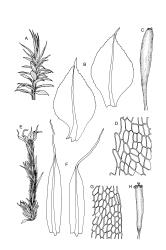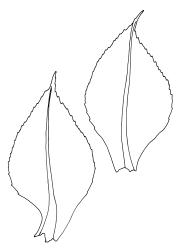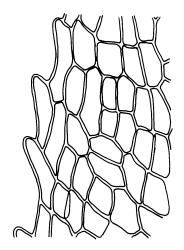- ≡ Dissodon callophyllus Müll.Hal., Bot. Zeitung (Berlin) 9: 546 (1851)
- ≡ Splachnum callophyllum (Müll.Hal.) Hook.f. & Wilson, Bot. Antarct. Voy. III. (Fl. Tasman.) Part II, 198 (1859)
- = Eremodon robustus Hook.f. & Wilson in Wilson, Bot. Antarct. Voy. II (Fl. Nov.-Zel.) Part II, 93 (1854)
Plants robust, pale green often suffused with purple, forming dense tufts. Stems not or sparsely branched, green or suffused with purple, 10–40(–90) mm, in cross-section pentagonal, beset with dark purple, smooth rhizoids. Leaves widely spreading to squarrose, moist, from a weakly sheathing base, crisped when dry, oblong-obovate to broadly elliptic, sometimes narrower at stem apex, abruptly tapered to a slender acumen, strongly toothed to spinose in upper ¾ or more, (2.3–)3.0–4.0 × 1.0–2.0(–2.3) mm; upper laminal cells thin-walled, weakly porose, oblong-hexagonal, c. 45–110 μm long, becoming shorter towards apex and margins, becoming larger and more oblong below, not arranged in diagonal files. Costa concolourous, c. 90 μm wide at ⅓ above base, often dilated below, terminating in or below the base of the acumen. Axillary hairs inconspicuous.
Dioicous. Perichaetial leaves not differentiated. Perigonia terminal, with strongly differentiated, erect and lanceolate bracts surrounding many antheridia intermixed with filiform, 6–7-celled paraphyses. Setae 10–15 mm, straight, smooth, c. 240 μm diam.; capsules erect, narrowly ellipsoid, with a weakly defined neck c. ½ the total capsule length, c. 5 mm long, red-brown at maturity; exothecial cells oblate-lunate throughout or irregular near base of urn, uniformly thick-walled; stomata restricted to a band at top of the neck; annulus not seen; operculum as per genus. Peristome teeth inserted below the mouth, erect or incurved when dry, yellow, longitudinally fused to form 8 compound teeth, broadly triangular with an obtuse apex, c. 260–300 × 80–90 μm, longitudinally striate on outer surface, finely papillose to irregularly striate on inner surface; preperistome not seen. Calyptra as per genus, c. 1.5 mm. Spores globose, 9–12 μm, smooth.
Goffinet 2006, fig 17, a–d; Seppelt et al. 2013, pl. 33.
The strongly toothed, broadly obovate to elliptic, and often purple-tinged leaves, and the narrowly ellipsoid capsules with incurved peristome teeth, make this species unmistakable in a N.Z. (and Tasmanian) context. The strongly differentiated, erect, and lanceolate bracts of the terminal perigonia are also striking and distinctive.
Tayloria purpurascens is sporophytically similar but rarely confused here; it can be readily distinguished by leaf margin differences. Goniobryum subbasilare, a species occasionally confused, has much narrower leaves with doubly-toothed margins.
Tayloria callophylla is similar in some respects to T. magellanica (Brid.) Mitt. This South American species, however, has narrower, more lanceolate leaves, which lack a distinct acumen, and generally shorter and more obtuse marginal teeth.
NI: N Auckland, including offshore islands (LB, GB), S Auckland (Coromandel Peninsula, Mangōnui County), Hawke's Bay (s.loc.), Wellington (Eastbourne); SI: Nelson (Cobb Valley, Stockton Plateau), Westland (Croesus Track, Lake Hochstetter, Ōkārito).
Australasian. Tasmania*.
Commonly associated with kānuka or manuka scrub, but growing in a variety of other forest types, including those dominated by kauri (including "gumlands"), Weinmannia, southern beech, and podocarps. Often on duff or humus, occasionally on rotten logs or tree fern caudices. Few herbarium records record the presence of faeces. On North I. from near sea level to c. 760 m (Moehau, South Auckland L.D.) and on South I. to 1030 m (Cobb Valley, Nelson L.D.).
Tayloria callophylla is best documented from areas north of 38°S, with only scattered collections known from south of this latitude. The only Hawke's Bay record is an early and unlocalised collection by Jolliffe (BM). The South I. occurrence of this species was questioned by Sainsbury (1955a) but there is a single early and unlocalised T. Kirk collection from Westland (CHR 217814, probably made in 1884 or 1885), as well as a few post-1989 collections from Nelson and Westland L.D.
The type locality is clearly stated in the protologue to be Mt Wellington in Tasmania. Seppelt et al. (2013) stated their belief that this is the only Tasmanian collection of the species. Earlier authors (Rodway 1914, p. 99; Sainsbury 1955b; Dalton et al. 1991) have raised doubt about the Tasmanian provenance of the type collection and, indeed, about the occurrence of the species on that island. However, concordance of the locality data on the isotype with that in the protologue supports the view that the Mossman-collected type is Tasmanian in origin. There is also a 19th century Tasmanian collection by Oldfield of the synonymous Eremodon robustus Hook.f. & Wilson in BM. The existence of the Oldfield collection corroborates the presumption that T. callophylla occurs in Tasmania, despite a lack of modern collections (Seppelt et al. 2013).








